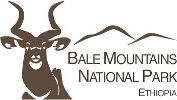Flora
There are about 1600 species of vascular plants in the Bale Mountains National Park, of which 177 (29.5% of Ethiopia’s endemic vascular plant species) are found in the Bale floristic region and 31 of them are restricted to Bale floristic region.
The Bale Mountains National Park is broadly classified into the five vegetation zones:
Gaysay valley grasslands – This is a small grassland area situated within a broad flat valley at an altitude of 2600-3000 m asl. This area, which is part of the northern projection of the BMNP boundary, is dominated by Artemisia afra, Ferula communis, Kniphofia foliosa, grasses and sedges, interspersed with wetlands covered mainly with cyperaceous plants.
Dry evergreen montane forest (or woodland) – Sometimes referred to as the northern or Gaysay woodlands, the lower altitudes between 2600 and 3200 m asl are dominated either by Juniperus procera or Hagenia abyssinica with the two species sometimes co-dominating on slopes. Other species that are not dominant but of significance include Hypericum revolutum, Myrsine melanophloeos, Erica arborea and Discopodium eremanthum. The shrub layer consists of Discopodium eremanthum, Solanum garae, S. marginatum and the endemic Euphorbia dumalis. The higher altitudes of the dry evergreen montane forest around Gaysay Valley are dominated by Hypericum revolutum between 3350 and 3500 m asl, Erica arborea between 3500 and 3800 m asl, while the vegetation above 3800 m asl is Helichrysum citrispinum and H. splendidum moorland.
Afroalpine - The central part of the park consists of an Afroalpine plateau between about 3200 and 4377 m asl. The area between 3550 and 4000m asl is covered by Erica shrub on ridges and Helichrysum moorland in the valleys. The undulating plateau itself is characterized by cushion-like H. citrispinum in the lower part and H. splendidum in the upper and generally flatter part of the plateau. The endemic giant lobelia (Lobelia rhyncopetalum), which stands up to 10 m high including its inflorescence, is scattered across the landscape up to the highest altitudes of Tullu Deemtu at 4377 m asl. At lower altitudes (3200 – 3500 m asl) such as in the Web Valley and Morebawa, the Afroalpine habitat is characterized by short, herbaceous plant communities dominated by Alchemilla (A. abyssinica, A. rothii, A. cyclophylla) pasture, Helichrysum (H. citrispinum, H. cyosum, H. gofense, H. splendidum) shrubs and Artemesia afra shrubs.
Ericaceous belt - This vegetation belt, composed mainly of Erica arborea and E. Trimera, is located between 3200-3800 m asl and forms an important vegetation belt between the high altitude Afroalpine plateau and the lower Harenna forest. It spans most of the escarpment areas, which is apparently the result of the moisture regime on slopes between 20 to 60°, though scattered Erica shrubs are also found on the high plateau in sheltered valleys up to 4200 m asl Both shrub and tree forms are present, as well as the remnants of ancient forests of Giant Heath (Erica arborea) in areas spared from excessive fire - for example above the Gaysay woodlands and at the lower altitudes of the Harenna escarpment before the transition to moist montane forest. The Giant Erica forests are draped with lichens and, in the absence of grazing, Alchemilla meadows flourish on the ground below. As one of only a few woody species found in the higher altitudes of the Bale Mountains, Erica is highly utilised for fuel and building by local people. The utility of this species, combined with the slow regeneration and growth rate as well as high grazing pressure by livestock, put the species and entire habitat under threat. The species is officially protected and conservation of Erica habitat is essential, both for Erica spp. and the other species this habitat supports.
Harenna moist montane forest - The Harenna Forest, rising from 1450 to 3200 m asl within a distance of only 8 km, is one of the most extensive and largely natural forests remaining in Ethiopia. It is typically divided into five altitudinal belts based on differences in tree species composition across the altitudinal gradient. The lower altitudinal belt between 1450 and 1500 m asl is characterized as Filicium-Warburgia-Podocarpus-Celtis forest. The lower part of this forest, which includes the transition between moist montane forest and the dry woodland north of Delo Mena town, is composed of both woodland taxa like Combretum molle and Terminalia brownii, and forest species like Warburgia ugandensis, Celtis africana and Podocarpus falcatus, among others. The vegetation belt between 1500 and 1700 m is also a dry evergreen forest with scattered Podocarpus falcatus trees and an understory of wild coffee (Coffea arabica). As a result of intense coffee management, there is considerable forest thinning taking place affecting the regeneration of some tree species. The vegetation belt between 1700 and 2100 m asl is characterized by tree species like Syzygium guineense, Polyscias fulva, Allophylus abyssinicus, Erythrina brucei, Croton macrostachyus and Canthium oligocarpum. One of the dominant trees, Erythrina brucei and a shrub, Vepris dainellii, are endemic to Ethiopia. Important timber trees like Ocotea kenyensis and Podocarpus falcatus are also found in this belt. The vegetation belt between 2100 and 2700 m asl is characterized by trees such as Hagenia abyssinica, Schefflera volkensii, Erythrina brucei, Galiniera saxifraga, Allophylus abyssinicus, Dombeya torrida, Ficus ovata, Prunus africana, Croton macrostachyus, Maytenus addat (endemic to Ethiopia) and Canthium oligocarpum. Regeneration in this vegetation belt is lacking due to heavy disturbance and overgrazing by cattle, horses and sheep. The vegetation belt between 2700 and 3000 m asl is characterised by species such as Hypericum revolutum, Schefflera volkensii, Hagenia abyssinica, Myrsine melanophloeos, Galiniera saxifraga and Erica arborea. High rainfall in this belt and high moisture allow very dense mats of mosses and epiphytes to flourish. In the upper part of this belt, there are permanent settlements and heavy disturbance from grazing and cultivation. Starting just below the escarpment, there is also a bamboo zone (2700-3400m a.s.l) that becomes a bamboo-Schefflera-Hagenia zone at lower altitudes (2300-2700m a.s.l); both of which are important habitats for the elusive and endemic Bale monkey.

